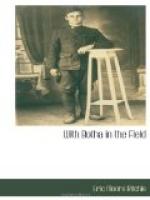[Illustration: A Beauty Spot passed during the last Trek] [Illustration: The Last Phase. Conference at Omaruru. German Staff lunching] [Illustration: The General receives his Bodyguard at a Garden Party after return]
The marvellous series of changes as one advances constitutes the most striking feature of the advance to Windhuk from the coast. By rail it is not so striking; but taking the marching route via the Swakop River water-holes—Swakopmund, Nonidas, Haigamkhab, Husab, Riet, Salem, Wilhelmsfeste (Tsaobis), Otjimbingwe, Windhuk—the changes in the country and the stages that show them are as palpable as if marked by a system of parallel walls. I have never seen this feature of the veld so marked elsewhere in South Africa.
Swakopmund is the limit in the down-grade—deep sand; brak water; a treacherous, dreary climate, with visitations of furnace-heat desert winds; a huge cemetery; moths and flies. From Nonidas to Haigamkhab and Husab the sand lightens and hardens, the atmosphere improves, rocks, barren kopjes begin to appear; the little water you get is fairly good. Riet comes; the barren kopjes are more frequent; the atmosphere, hot in the day, is beautiful by night; the water is perfect. Salem is a duplicate Riet; a small settlement in the river bed; but the water is more plentiful, the vegetation more profuse. Then comes the great trek to Tsaobis.
It does not look far on the map; it is a huge stretch nevertheless. For the first three hours it was Riet-Salem country with extensions and additions. Vast gorges, black and brown kopjes, boulders, sand stretches, clumps of bush, minute trees. And then, on Thursday the 29th of April (memory holds the date like a vice), we saw grass. It was grass. It was undoubtedly grass—the kind of grass that gave one the feeling that this particular veld, like a man prematurely bald through worry or riotous living, had been trying some hair restorer with ludicrous results—grass whitish, feeble, attenuated, that to be seen at all wanted an eye levelled along the ground.




